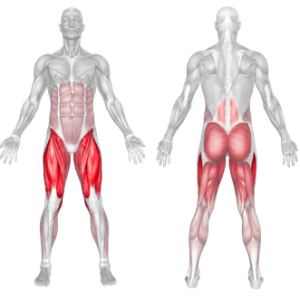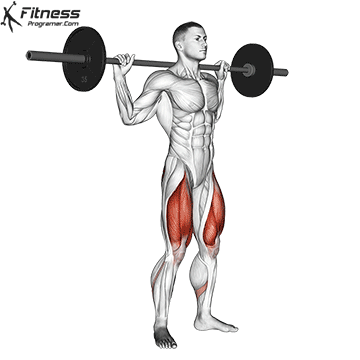Barbell Squat Overview
The barbell squat is a strength training exercise that targets the muscles of the lower body, particularly the quadriceps, hamstrings, and glutes. It is a compound exercise, meaning it works multiple muscle groups simultaneously. The exercise is performed using a barbell, which is a long, straight bar that is weighted with plates.
How to Perform the Barbell Squat
1. Set-Up
- Rack Position: Adjust the barbell to chest height on a squat rack.
- Barbell Placement: Place the barbell across your upper traps for a high-bar squat or your rear delts for a low-bar squat.
- Grip: Hold the bar slightly wider than shoulder-width, keeping your wrists neutral.
2. Starting Position
- Step under the barbell and position it securely on your back.
- Lift the bar off the rack by extending your knees and stepping back.
- Stand with your feet shoulder-width apart, toes slightly turned out.
3. Squatting Motion
- Lowering Phase:
- Inhale deeply to brace your core.
- Push your hips back and bend your knees to lower your body.
- Keep your chest up and spine neutral as you descend.
- Lower until your thighs are at least parallel to the ground (or deeper, if mobility allows).
- Rising Phase:
- Exhale as you push through your heels to return to a standing position.
- Extend your hips and knees fully while keeping your chest upright.
4. Re-Rack the Barbell
- After completing your set, step forward and carefully re-rack the barbell.
Tips for Proper Form
- Core Engagement: Keep your core tight to stabilize your spine.
- Knee Alignment: Ensure your knees track over your toes to avoid strain.
- Depth: Aim for full range of motion; at least parallel or lower if mobility allows.
- Neutral Spine: Avoid rounding or over-arching your back during the movement.
- Breathing: Inhale during the descent and exhale as you push back up.
- Foot Placement: Adjust stance width and toe angle for comfort and alignment.
Common Mistakes
- Rounding the Back: Losing spinal alignment can increase injury risk.
- Knees Caving In: Allowing knees to collapse inward compromises stability.
- Shallow Depth: Not squatting deep enough limits muscle engagement.
- Uneven Bar Placement: Placing the bar unevenly can lead to imbalance.
- Overloading the Bar: Using too much weight can sacrifice form and increase injury risk.
Benefits of the Barbell Squat
- Lower-Body Strength: Targets quadriceps, hamstrings, and glutes effectively.
- Core Stability: Strengthens the core to support the spine and improve posture.
- Improved Mobility: Enhances hip, ankle, and knee flexibility.
- Athletic Performance: Boosts power, speed, and agility for sports activities.
- Bone Density: Weight-bearing nature promotes stronger bones.
- Hormonal Response: Stimulates the release of growth hormone and testosterone, aiding muscle growth.
- Functional Strength: Mimics real-life movements, improving daily activities like lifting and climbing.
How to Incorporate Into Your Routine
- Strength Training: Perform 3–5 sets of 5–8 reps with heavier weight for strength gains.
- Hypertrophy: Use moderate weight for 3–4 sets of 8–12 reps to build muscle size.
- Endurance: Opt for lighter weight and higher reps (12–15) for muscular endurance.
- Warm-Up Sets: Include lighter barbell squats in your warm-up to activate your legs and core.
- Accessory Work: Pair with hamstring curls, Bulgarian split squats, or lunges for a comprehensive leg workout.
- Periodization: Alternate barbell squats with variations like front squats or goblet squats to avoid plateaus.
Barbell Squat Muscles Worked


